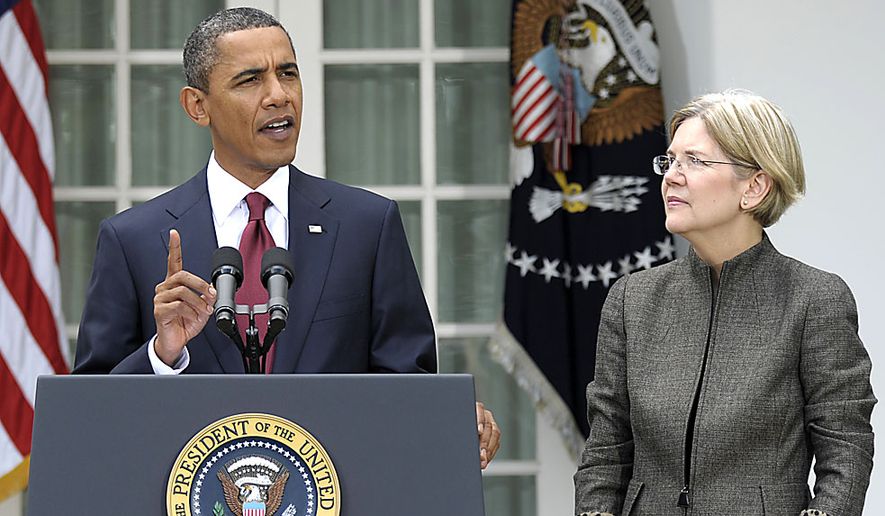The Consumer Financial Protection Bureau — the Wall Street cop agency devised by then-Harvard professor Elizabeth Warren and launched under President Obama — puts too much power in a single director, making it unconstitutional, the Supreme Court ruled Monday.
But the justices left the agency intact, saying it could be fixed by giving the president the power to fire the director.
Chief Justice John G. Roberts Jr., writing the key opinion in the 5-4 ruling, said Congress went too far when it created the CFPB with a single director, appointed for a five-year term, who controls an independent budget and cannot be fired by the president without good cause.
“The Constitution requires that such officials remain dependent on the president, who in turn is accountable to the people,” the chief justice wrote.
But rather than strike down the entire agency, he said the problems could be fixed by treating the CFPB director like any other officer who is removable at the president’s whim.
“If the director were removable at will by the president, the constitutional violation would disappear,” the chief justice wrote.
Congress foresaw this exact situation and wrote a “severability” clause into the law, allowing the courts to jettison any unconstitutional provisions.
The decision is a defeat for Ms. Warren, a law professor at the time, who pushed the idea of an independent watchdog over Wall Street in the wake of the 2008 financial collapse and ensuing Great Recession.
She had wanted an agency that would be immune to political pressure, with a director who cannot easily be fired by the president and a budget set by the director independently of Congress.
In 2010, a Democrat-controlled Congress joined with Mr. Obama to include that as the centerpiece of the Dodd-Frank Wall Street Reform and Consumer Protection Act.
Opponents had warned that the idea was likely unconstitutional.
The high court agreed, saying the president’s power to oust officers is inherent in the constitutional structure. There are some exceptions the court has allowed over the years, but never with so much independence as the CFPB, with a single director and control of its own budget, the majority said.
Indeed, that was exactly the situation President Trump found himself in when he took office, saddled with Richard Cordray as CFPB director. He is an Obama-appointed disciple of Ms. Warren and was, according to the law, immune from Mr. Trump’s influence.
He created even more controversy when he left in late 2017, and tried to elevate his own pick to replace him, attempting to deny Mr. Trump even that opportunity to exert his executive appointment powers. The courts sided with Mr. Trump on that question.
Mr. Trump would first install his own budget director as acting CFPB director, then later substitute another pick of his choosing, giving him better control of the agency.
Dissenting on Monday were the high court’s four Democrat-appointed justices, led by Justice Elena Kagan, who accused the majority of “gerrymandered” reasoning, picking and choosing from court precedent and history to create a way to eviscerate the CFPB.
She pointed out that the court has repeatedly allowed similar powers of independence for agencies headed by a board or commission, made up of multiple people. And she questioned why a single director would be any different.
She wrote that the Constitution never specifically gives the president removal powers, and the issue was heatedly debated during the Founding.
“In second-guessing the political branches, the majority second-guesses as well the wisdom of the Framers and the judgment of history,” she wrote. “It writes in rules to the Constitution that the drafters knew well enough not to put there. It repudiates the lessons of American experience, from the 18th century to the present day. And it commits the nation to a static version of governance, incapable of responding to new conditions and challenges.”
On the other side was Justice Clarence Thomas, who sided with the majority in saying the CFPB director was unconstitutional, but said he would have ruled the entire agency out-of-bounds. He said the courts are no place to rewrite the law.
But he went further, saying the cases Justice Kagan cited that validated other independent agencies in the past are wrong. He complained there are “numerous, unaccountable independent agencies that currently exercise vast executive power outside the bounds of our constitutional structure.”
The CFPB enforces more than a dozen consumer laws.
Hans Bader, a D.C.-based lawyer who in 2011 developed the argument that the single-director CFPB was different than multi-commissioner boards, said he had hoped a Republican president could use it to fire an Obama-appointed director.
“But it took so long for the legal challenge to reach the Supreme Court, that now, it may be used by President Biden to fire Trump’s CFPB Director (whose term would otherwise continue until 2023),” Mr. Bader wrote in an email.
He pointed out that bank stocks started dropping Monday after the ruling, suggesting investors, too, were worried about what Mr. Biden might do.
Some on the political left complained about the ruling, saying it stripped too much independence from the CFPB.
But others, including House Speaker Nancy Pelosi, who helped lead the push for the 2010 law, cast the ruling as a victory, saying the power of the CFPB to police Wall Street remains intact, whatever the composition of its leadership.
“Since its creation nearly a decade ago, the bureau has served as a life-or-death watchdog for the millions of consumers targeted by predatory and abusive financial actors,” Mrs. Pelosi said.
• Stephen Dinan can be reached at sdinan@washingtontimes.com.




Please read our comment policy before commenting.